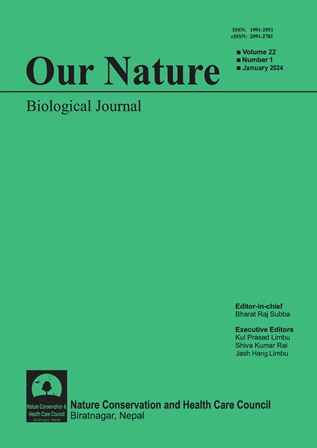Assessment of the surface water quality in high-altitude springs in the Sagarmatha (Everest) National Park, Nepal
DOI:
https://doi.org/10.3126/on.v22i1.67345Keywords:
Degradation, Human impacts, Physico-Chemical Characteristics, Springs, Water qualityAbstract
This study's goal was to examine how the physico-chemical properties of high-altitude springs in eastern Nepal's Sagarmatha National Park and buffer zone changed annually over a period of three years (2008-2010). The majority of the sampling locations were chosen along the treks from Lukla to Everest Base Camp, Gokyo, and Imja valley. Chemical parameters, such as total nitrogen and total phosphorous, were studied in the ecology laboratory of Central Department of Botany, Tribhuvan University, while physical characteristics such as pH, temperature, total dissolved solids (TDS), and conductivity were assessed on the spot by water analyzer kit Although water quality standards still meets the WHO's and Nepal's standards for drinking water, the quality of the spring water is starting to deteriorate. On the main tourist treks, Changes in water quality metrics in water bodies have been observed. Each year, the values of total nitrogen (TN-NO3), total phosphorous (TP-PO4), and pH change, indicating a decline in the quality of the springs water bodies in the Sagarmatha National Park and Buffer Zone (SNPBZ). The values of TN-NO3 and TP-PO4 had significantly increased, indicating that human impact had also increased. Although the amount of total nitrogen in water samples was lower than the WHO limit, there has been an increase in nitrate-nitrogen as compared to past findings. Similar to this, it was discovered that the total phosphorus value increased both annually and in earlier reports. Therefore, sufficient care should be taken to stop future deterioration. The research produced a database for the current state of Nepal's highland springs, which may be used to manage the springs and research how human activity affects water quality.
Downloads
Downloads
Published
How to Cite
Issue
Section
License
Copyright (c) 2024 The Author(s)

This work is licensed under a Creative Commons Attribution-NonCommercial 4.0 International License.
This license enables reusers to distribute, remix, adapt, and build upon the material in any medium or format for noncommercial purposes only, and only so long as attribution is given to the creator.




